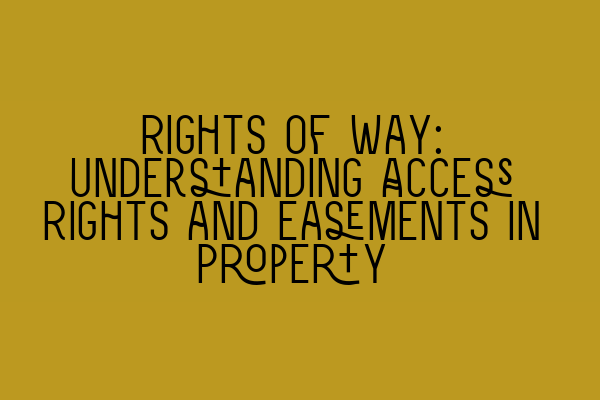At SQE Property Law & Land Law, our team of solicitors are well-versed in the complexities of property law. One topic that often arises in property transactions is the issue of rights of way and easements. Understanding these access rights is crucial for property owners, as it can affect their use and enjoyment of the land. In this blog post, we will delve into the intricacies of access rights and easements, providing you with the knowledge you need to navigate this aspect of property law.
What are Rights of Way?
Rights of way refer to the legal right to access or pass through another person’s land. They can be beneficial for those who need to cross someone else’s property to reach their own land or a public space, such as a road or a beach. Rights of way can be established by law, through agreements between landowners, or by long-term use. Understanding the different types of rights of way is essential for both property owners seeking to protect their land and those who require access through someone else’s property.
Types of Rights of Way
There are several types of rights of way, including:
- Express Grant: This is a right of way that is explicitly granted in a legal document, such as a deed.
- Prescriptive Easement: This is a right of way that is acquired through long-term use. If someone has continuously used a particular route for a certain period of time (typically 20 years), they may acquire a legal right to continue using that route.
- Necessity: A right of way by necessity is granted when there is no other access to a property except through another person’s land. This typically occurs when a property is landlocked, meaning it has no direct access to a public road.
It is important to note that rights of way can be both public and private. Public rights of way are paths or routes that are available for public use, such as footpaths or bridleways. Private rights of way, on the other hand, only allow access to specific individuals or properties.
Understanding Easements
An easement is a legal right granted for a specific purpose that allows one party to use a portion of another party’s land. Easements can be created through an express grant, by necessity, or by long-term use (prescriptive easement). While rights of way are a type of easement, there are other types of easements that can grant different rights to a property owner.
Types of Easements
There are several types of easements, including:
- Right to Light: This easement grants a property owner the right to receive light through a specific window or opening in a neighboring property. It ensures that a property is not unduly deprived of natural light.
- Right to Drain: This easement allows a property owner to drain water onto a neighboring property. It is often used for rainwater drainage or sewage disposal purposes.
- Right of Support: This easement grants a property owner the right to have their land supported by a neighboring property. It is particularly relevant in cases where one property is excavated, and the stability of the neighboring property is affected.
These are just a few examples of the types of easements that can exist. The specific easements applicable to a property will depend on the circumstances and any agreements or legal documents in place.
Resolving Disputes over Rights of Way and Easements
Disputes regarding rights of way and easements can arise when there is disagreement over the extent of the rights granted, interference with the rights, or conflicting use of the land. In such cases, it is advisable to seek legal advice to understand your rights and responsibilities as a property owner.
If you find yourself in a dispute over a right of way or easement, there are various methods for resolution, including:
- Negotiation: This involves discussions between the parties involved to reach a mutually agreeable resolution.
- Mediation: A neutral third party mediates the dispute, assisting the parties in reaching a resolution.
- Arbitration: The parties present their case to an arbitrator, who then makes a binding decision.
- Litigation: If all other attempts at resolution fail, the dispute may be taken to court for a judge to make a determination.
Resolving disputes can be time-consuming and costly, so it is important to seek legal advice early on to explore all possible avenues for resolution.
Conclusion
Rights of way and easements are complex legal concepts that play a significant role in property law. Whether you are a property owner seeking to protect your land or in need of access through someone else’s property, understanding these access rights is vital. Our team at SQE Property Law & Land Law can provide expert advice and guidance to help you navigate these legal complexities. Contact us today to discuss your rights and obligations when it comes to rights of way and easements.
Related Articles:
- Ethics in Contract Law: Navigating the Moral and Legal Dimensions
- Misrepresentation in Contracts: Unveiling Deceptive Practices
- A Closer Look at SQE Contract Law Syllabus
- SQE Contract Law: Analyzing Landmark Cases and Influential Judicial Decisions
- Contract Law for Services: Key Considerations and Best Practices
